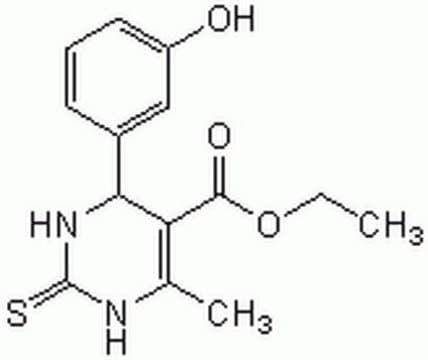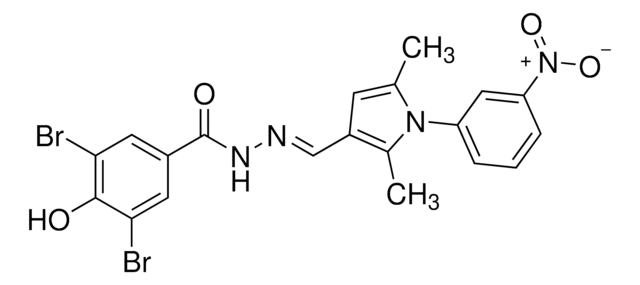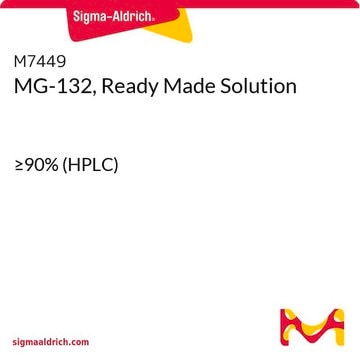M8515
Monastrol
≥98% (HPLC), solid
Sinónimos:
4-(3-Hydroxyphenyl)-6-methyl-2-thioxo-1,2,3,4-tetrahydro-4H-pyrimidin-5-carboxylic Acid Ethyl Ester
About This Item
Productos recomendados
Nivel de calidad
Ensayo
≥98% (HPLC)
Formulario
solid
condiciones de almacenamiento
protect from light
color
white to off-white
mp
185-185.9 °C (lit.)
solubilidad
DMSO: >5 mg/mL
temp. de almacenamiento
2-8°C
cadena SMILES
CCOC(=O)C1=C(C)NC(=S)NC1c2cccc(O)c2
InChI
1S/C14H16N2O3S/c1-3-19-13(18)11-8(2)15-14(20)16-12(11)9-5-4-6-10(17)7-9/h4-7,12,17H,3H2,1-2H3,(H2,15,16,20)
Clave InChI
LOBCDGHHHHGHFA-UHFFFAOYSA-N
Aplicación
- to treat MDA-MB-231 cells as a non-microtubule-targeting agent
- as a antineoplastic agent, to treat mouse myeloma cell line SP 2/0, to induce apoptosis and to elucidate the role of metabotropic glutamate receptor 3 (Grm3) in apoptosis
- as an inhibitor of pteridine reductase in GFP-transfected promastigotes infected macrophages for flow cytometer-based growth inhibition assay and to evaluate anti-leishmanial activity of Leishmania donovani hamster model in vivo
Acciones bioquímicas o fisiológicas
Características y beneficios
Envase
Código de clase de almacenamiento
11 - Combustible Solids
Clase de riesgo para el agua (WGK)
WGK 3
Punto de inflamabilidad (°F)
Not applicable
Punto de inflamabilidad (°C)
Not applicable
Equipo de protección personal
Eyeshields, Gloves, type N95 (US)
Elija entre una de las versiones más recientes:
Certificados de análisis (COA)
¿No ve la versión correcta?
Si necesita una versión concreta, puede buscar un certificado específico por el número de lote.
¿Ya tiene este producto?
Encuentre la documentación para los productos que ha comprado recientemente en la Biblioteca de documentos.
Artículos
Cell cycle phases (G1, S, G2, M) regulate cell growth, DNA replication, and division in proliferating cells.
Cell cycle phases (G1, S, G2, M) regulate cell growth, DNA replication, and division in proliferating cells.
Cell cycle phases (G1, S, G2, M) regulate cell growth, DNA replication, and division in proliferating cells.
Cell cycle phases (G1, S, G2, M) regulate cell growth, DNA replication, and division in proliferating cells.
Nuestro equipo de científicos tiene experiencia en todas las áreas de investigación: Ciencias de la vida, Ciencia de los materiales, Síntesis química, Cromatografía, Analítica y muchas otras.
Póngase en contacto con el Servicio técnico








